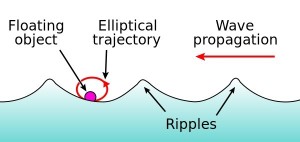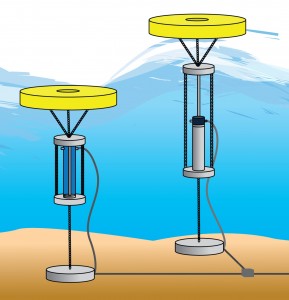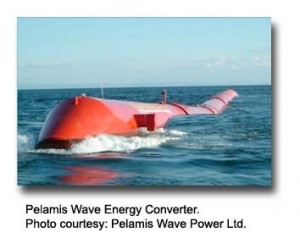-
Ocean energy comes in four distinct types (five if you include offshore wind energy – see earlier blog on this topic): wave energy, ocean current energy, tidal energy, and OTEC (ocean thermal energy conversion). Together they represent a major new energy source for the world and all have been shown to work. The major problems are reliability and cost and all are in early stages of development.
Given the potential length of this blog, and my goal to keep each blog easily readable, I have decided to break up the ocean energy blog into two parts, the first on wave energy (Part 1), to be published today, and the second on the three other listed ocean energy technologies: ocean current energy, tidal energy, and OTEC (Part 2), to be published in a few days.
Part 1: Wave Energy
Wave energy is the most advanced, with a large and growing literature and several operating demonstration sites. Wikipedia defines ‘wave energy’ as “…the transport of energy by ocean surface waves, and the capture of that energy to do useful work – for example, electricity generation, water desalination, or the pumping of water (into reservoirs).” Wikipedia further explains that “Waves are generated by wind passing over the surface of the sea. As long as the waves propagate slower than the wind speed just above the waves, there is an energy transfer from the wind to the waves.”
It is interesting to note that since wind energy is an indirect form of solar energy (winds are generated by uneven heating of the earth’s surface by solar radiation) then so is wave energy. Waves are irregular, varying in frequency and height, and successful wave power conversion systems will tap as much as possible of the kinetic energy in the up and down motion of waves to generate electricity or mechanical power. R&D efforts, of which there are now many with a major testing/demonstration site off the coast of Scotland, are focused on doing this energy capture at the lowest possible cost. Many different designs are being created and tested.
What is wave energy’s potential? The answer is huge – the kinetic energy in wave motion is a big number. Specifically, the Ocean Energy Council states that “An average 4-foot, 10-second wave striking a coast puts out more than 35,000 horsepower per mile of coast.” Another estimate (Wikipedia) is that “In major storms, the largest waves offshore are about 15 meters high and have a period of about 15 seconds, …such waves carry about 1.7 MW of power across each metre of wavefront.” The global potential is estimated to be more than 2 terrawatts (TW) – current global generating capacity is a bit more than 5 TW.
Wave energy also offer several advantages over other renewable energy technologies: it is produced 24/7, is more steady in output than wind or solar (i.e., higher capacity factors), has lower infrastructure costs (requires no access roads ), and is less obtrusive visually than offshore or land-based wind turbines. Of course wave energy still requires cabling to deliver power to shore and incurs all the difficulties of operating reliably in a marine environment. The next decade should see considerable progress in developing this technology and realizing its potential. Please stay tuned!




I thought wave power followed Weibull distributions.
If so, 24/7 is not a very appropriate description and waves are no more and no less steady than winds.
Capacity factor is simply a matter of choosing the size of electrical machine in a given device, wind or wave. Reducing the rating increases the capacity factor and the economic optimum is quite flat, at least for wind machines.
Well, you got me there – was not familiar with Weibull distributions (but am now). My point about wave energy was simply that it’s there most of the time and is closer to ‘baseload’ than other variable renewables like solar and wind. If I’m wrong I stand corrected. What do others have to say about this?